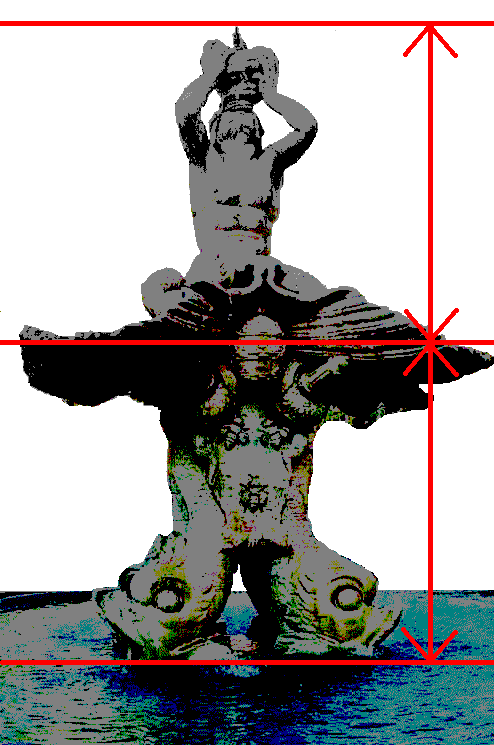
==================================

by Guy Shaked
Keywords: Botticelli, Fontana del Tritone, Gianlorenzo Bernini, Glaucus, Metamorphoses, Ovid, Shaked, Triton fountain, Venere, Venus
This fountain Finished in 1643 and situated at piazza Barberini, is one of Bernini's more famous works. It is positioned in the center of the piazza, and its main figure is Glaucus - half fish half man - rising from an open seashell and below him four dolphins, which keeps his seat afloat.
The fountain is called "Fonatana di Tritone" and is thought to represent Triton sounding his shell as is described in Ovid's Metamorphoses [1], however it actually represents Glaucus, the half man half fish Greek fisherman turned into god, as is testified in both Baldinucci's and Domenico Bernini's biographies of Bernini which were writen near the time he lived by people who were close to him [2].
Glaucus was a Greek fisherman, turned into half fish form by magic herbs he ate [3]. He also is depicted in the Metamorphoses as sounding the shell: "Behold Glaucus, sounding with his shell upon the sea, a new-come dweller in the deep waters" [4]. He is connected to Italy, for he fell for one of its maidens - Scylla (before disfigured by a potion) when he saw her in the Italian coast [5].
Glaucus rises from the shell like Botticelli's Venus from the bottom of the sea. The statue also shows a connection to the other fountain in this piazza, the Bees fountain, both containing seashell and bees.
The four dolphins at the base of the statue, are what enable Glaucus to have a form from "dis-formed" water. They turn toward the water, creating in the statue two opposite directions of motion, downward (dolphins) and upward (Glaucus). This is a result of the dolphins turning toward their natural medium while being for a short while outside it, in a similar manner to other animals in Bernini's fountains.
The statue displays a continuum of "watery" objects: water basin, four dolphins, the shell serving as Glaucus's seat, Glaucus, and the shell of water he sounds. The seashell he sounds, which is flowing water, symbolizes the rivers, rising to flood the planes. Their loud voice is symbolized by the sound of the shell (serving here as a kind of horn or trumpet).
----------------------------------------------
[1] Ovid, Ovid, Metamorphoses, (Miller, F. J., tr.), Cambridge, Harvard University Press, 1944, p. 27
[2] Baldinucci, F., Cit., p. 19. Bernino, D., Cit., p. 61. Another case of a Glaucus fountain which was named (by some) a Tritone (Triton) fountain is the one at Villa Trabia in Palermo made by Filippo Pennino and finished at 1779. See: www.exibart.com/notizia.asp?IDNotizia=3449&IDCategoria=51 (01/06/04)
[3] Ovid, Metamorphoses, p. 295
[4] Ovid, Metamorphoses, p. 293
[5] Ovid, Metamorphoses, p. 301
Dear visitor, please take a short moment to sign my guest book!
----------------------------------------------------------------

© 2003-2004 Emails are
gladly received: shakedtg@hotmail.com
Hidden symbolism in Bernini's David
The nudity of Michelangelo's David
The horns as the sign of the betrayed in Michelangelo's Moses
The Trevi Fountain as the soul in love and the flood that would not drown the church
Canova's Eve as depicting a conversion to Christianity
Other articles by G. Shaked:
ART
BIBLICAL STUDIES
BIOLOGY
CINEMA
LITERATURE
MUSIC
PHILOSOPHY
PHYSICS
(ACOUSTICS)